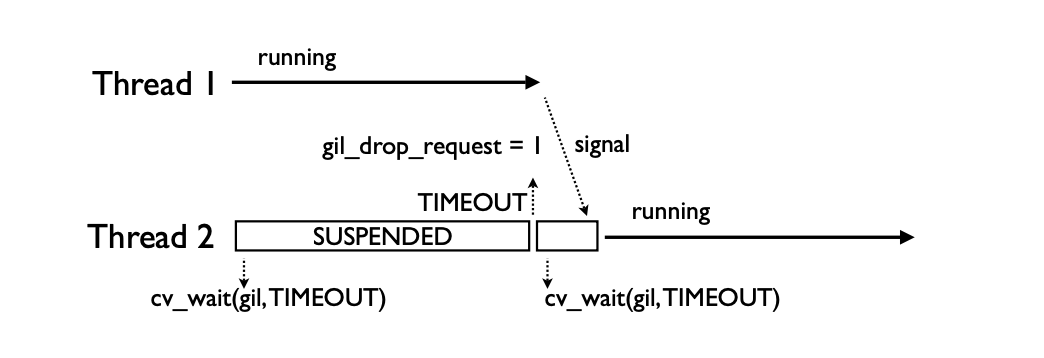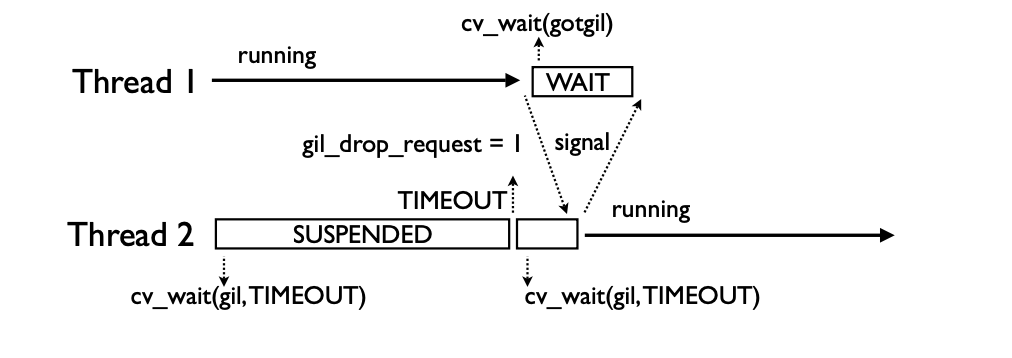Python 和 GIL
C Python 有一个 全局解释器锁 (GIL)
它有时候会是线程“争用”的来源
它对线程施加了各种限制(您不能使用多个 CPU), 限制了线程性能

什么是线程?
-
Python 线程是真正的系统线程
POSIX 线程(pthreads) Windows 线程 -
完全由主机操作系统管理
所有调度/线程切换
-
Python的线程执行解释器过程(用C编写)
线程创建
Thread类执行 run 方法
• Python threads simply execute a "callable"
• The run() method of Thread (or a function)
import time
import threading
class CountdownThread(threading.Thread):
def __init__(self,count):
threading.Thread.__init__(self)
self.count = count
--> def run(self):
while self.count > 0:
print "Counting down", self.count
self.count -= 1
time.sleep(5)
return
Python创建一个小型数据结构 包含一些 解释器状态 (interpreter state)
启动一个新线程(pthread)
线程调用 PyEval_CallObject
最后,运行的 C 函数 调用 指定的 Python 可调用对象
线程特定状态 PyThreadState
-
每个线程都有自己特定的解释器数据结构 (
PyThreadState)• 当前堆栈框架 Current stack frame (for Python code) • 当前递归深度 Current recursion depth • Thread ID • 一些每线程异常信息 Some per-thread exception information • 可选的跟踪/分析/调试 hook Optional tracing/profiling/debugging hooks
-
它是一个小型 C 结构(<100 字节)
typedef struct _ts {
struct _ts *next;
PyInterpreterState *interp;
struct _frame *frame;
int recursion_depth;
int tracing;
int use_tracing;
Py_tracefunc c_profilefunc;
Py_tracefunc c_tracefunc;
PyObject *c_profileobj;
PyObject *c_traceobj;
PyObject *curexc_type;
PyObject *curexc_value;
PyObject *curexc_traceback;
PyObject *exc_type;
PyObject *exc_value;
PyObject *exc_traceback;
PyObject *dict;
int tick_counter;
int gilstate_counter;
PyObject *async_exc;
long thread_id;
} PyThreadState;
线程执行
- 解释器有一个全局变量,简单地指向当前运行的
线程的 ThreadState 结构
/* Python/pystate.c */
...
PyThreadState *_PyThreadState_Current = NULL;
- 解释器的操作(隐式的)依赖于这个变量,来确定当前执行工作的线程
GIL global interpreter lock 锁
不是一个简单的 互斥锁 mutex lock
它是一个二进制信号量,由 pthreads 互斥量和条件变量构成
locked = 0 # Lock status
mutex = pthreads_mutex() # Lock for the status
cond = pthreads_cond() # Used for waiting/wakeup
GIL 是这个锁的一个实例
release() {
mutex.acquire()
locked = 0
mutex.release()
cond.signal()
}
acquire() {
mutex.acquire()
while (locked) {
cond.wait(mutex)
}
locked = 1
mutex.release()
}
GIL确保确保每个线程运行时, 都得到对解释器内部的独占访问
线程在运行时持有 GIL, 他们在阻塞 I/O时释放它
所有解释器锁定都基于信号
要获取 GIL,请检查它是否 free。如果不行,去等待信号
要释放 GIL,释放它并发出信号

处理 CPU 密集线程,这些线程从不执行任何 I/O,解释器定期执行“检查”

默认情况下,check一次 每 100 个 ticks
The Check Interval 检查间隔 是一个全局计数器,它完全独立于线程的调度
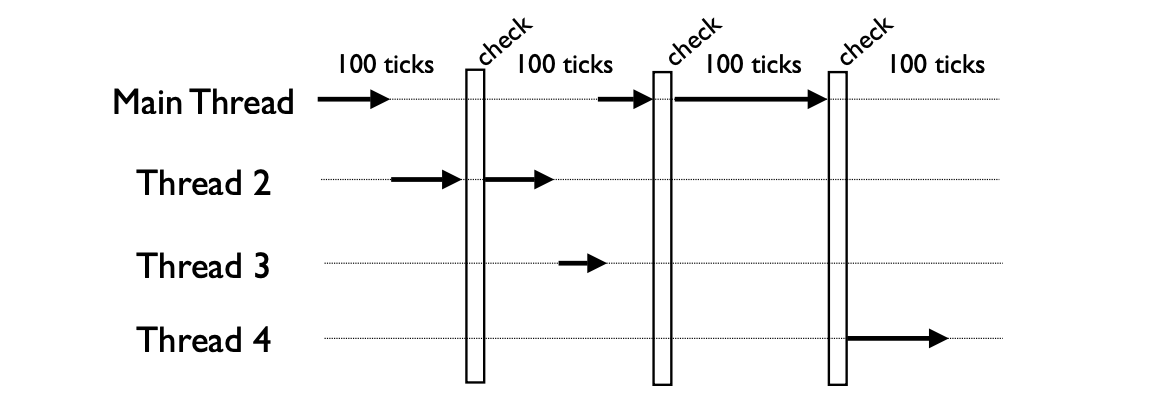
The Periodic Check 定期检查期间会发生什么?
-
信号处理程序(
signal handlers) 将执行待执行的signals(仅在主线程中) -
释放, 获取
GIL
/* Python/ceval.c */
...
if (--_Py_Ticker < 0) {
...
_Py_Ticker = _Py_CheckInterval;
...
if (things_to_do) {
if (Py_MakePendingCalls() < 0) {
...
}
}
if (interpreter_lock) {
/* Give another thread a chance */
...
PyThread_release_lock(interpreter_lock);
/* Other threads may run now */
PyThread_acquire_lock(interpreter_lock, 1);
...
}
什么是 Interpreter Ticks
映射到 解释器
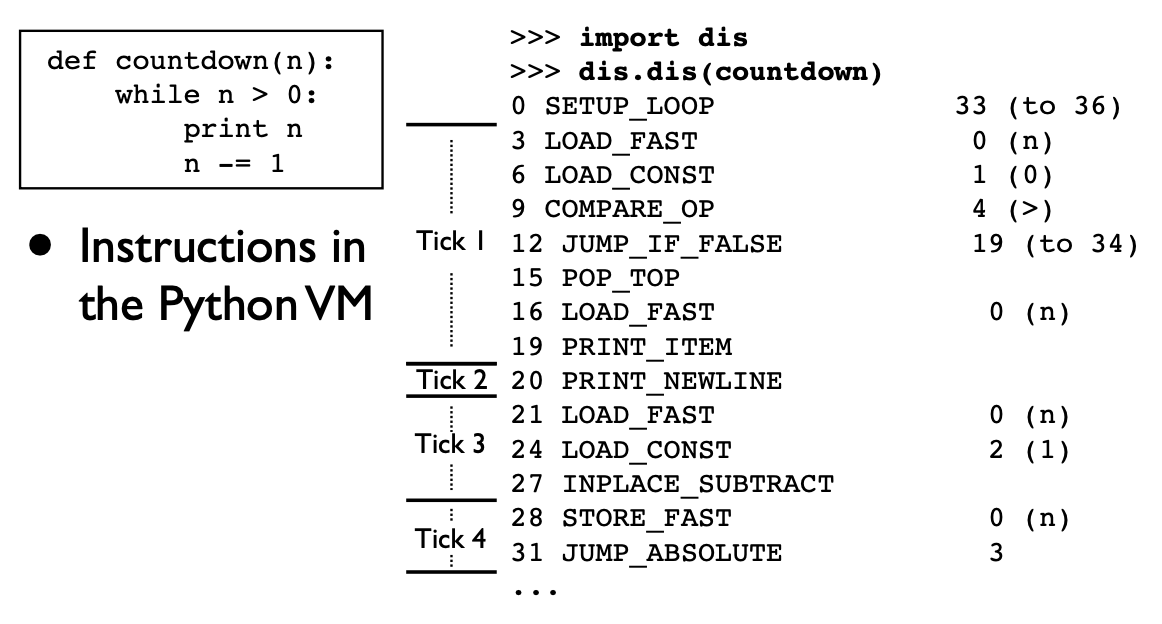
Interpreter ticks 不是基于时间的
x = (i for i in range(100000000))
print(-1 in x)
# Ctrl + C 不能打断 ticks
Signals
为什么 Python线程编程 不能再被 keyboard interrupt 杀死?
必须使用 kill -9 在单独的窗口中关闭
如果 signal 到达,解释器在每次 tick 之后 check, 直到主线程运行
尝试尽可能快地切换线程, 可能希望 main 线程会运行
由于信号处理程序 signal handlers只能在主线程运行,解释器快速 获取/释放 GIL,直到它被调度
所以它只是尝试尽可能快地切换线程, 可能希望 main 线程会运行
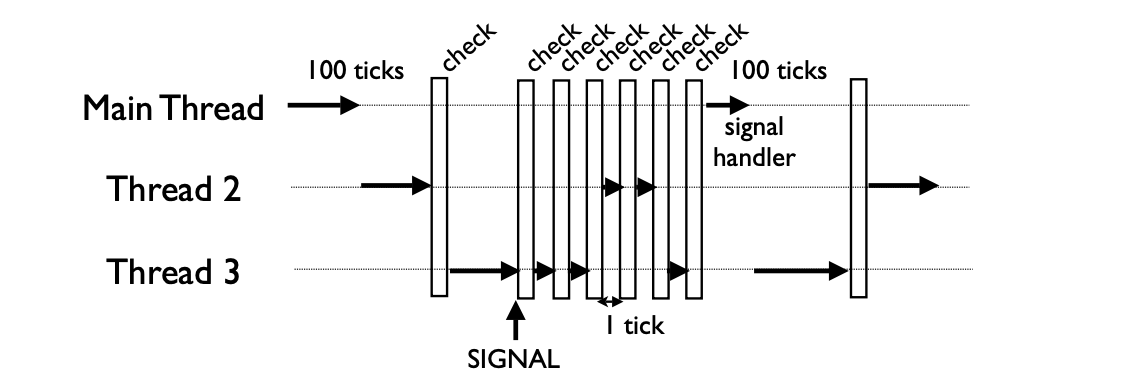
Thread Scheduling 线程调度
-
Python 没有
线程调度器 -
没有
线程优先级的概念, 抢占、循环调度等There is no notion of thread priorities, preemption, round-robin scheduling, etc.
-
所有线程调度都留给
操作系统(例如 Linux、Windows 等)这就是信号变得如此奇怪的部分原因 解释器无法控制调度所以 它只是尝试尽可能快地切换线程可能希望 main 会运行
Thread Scheduling 线程调度
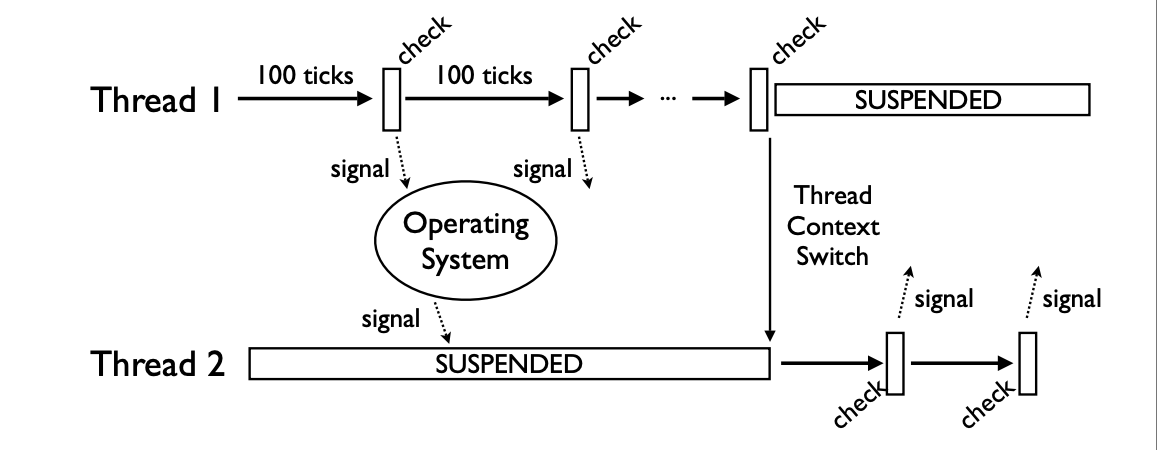
-
信号和执行之间的滞后 取决于操作系统 -
操作系统 会先执行最高“优先级”的线程
• CPU-bound : low priority • I/O bound : high priority
如果一个信号被发送到一个低优先级的线程,并且CPU忙于更高的优先级任务,它不会运行,直到稍后的时间点
CPU-Bound Threads CPU 密集线程
GIL Battle
两个 CPU-bund 型线程
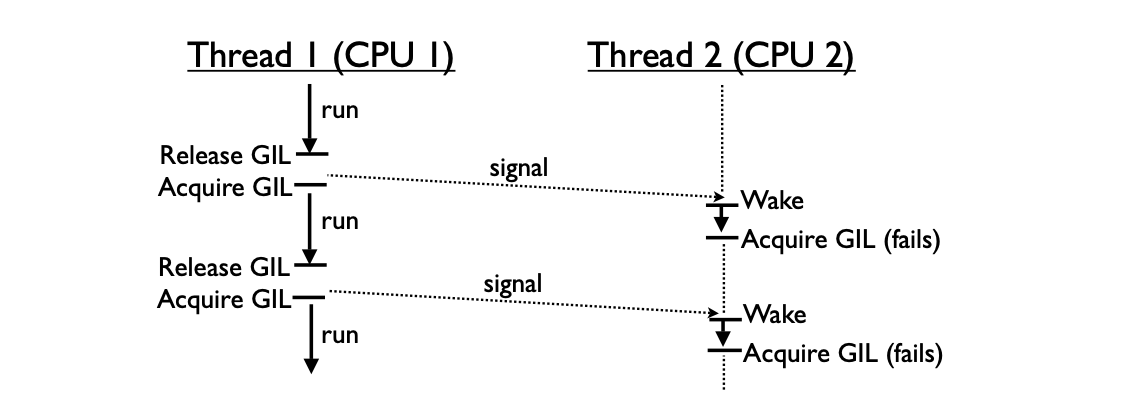
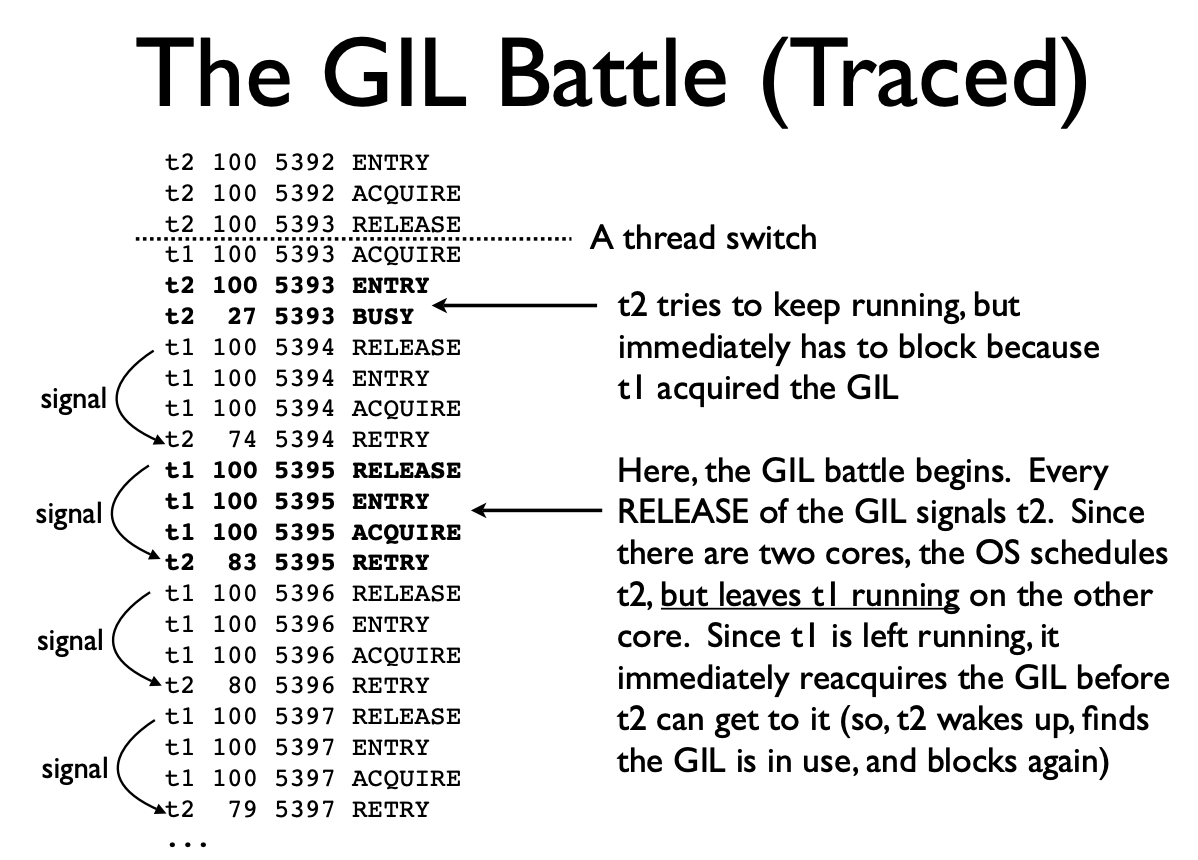
一个 CPU-bund 一个 I/O -bund
会降低 I/O 绑定线程 的响应时间
因为 I/O 线程不能足够快地醒来以获得 GIL (I/O bund 优先级反转)
只发生在多核

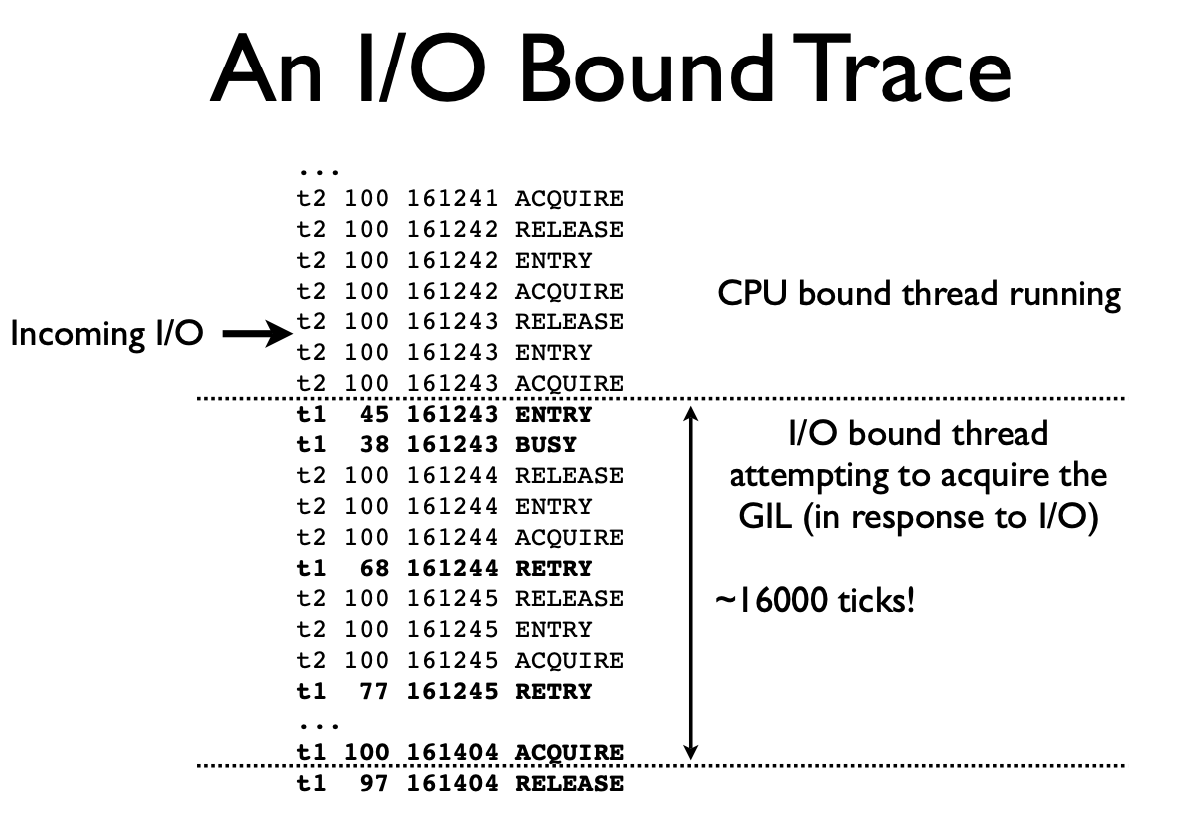
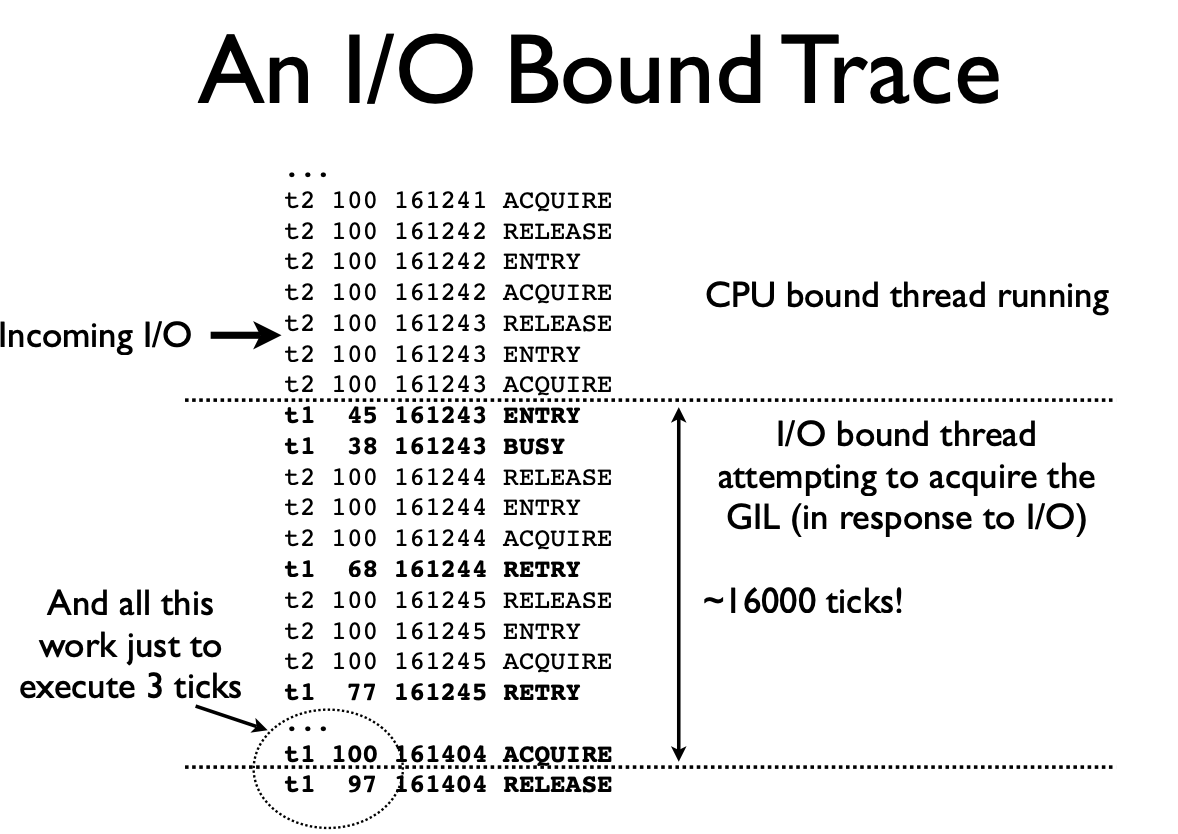
新的 GIL 实现 (python3.2)
only available by svn checkout
不是ticks,现在有一个全局变量 gil_drop_request
/* Python/ceval.c */
...
static volatile int gil_drop_request = 0;
线程一直运行 直到该值设置为 1 , 此时,线程必须丢弃 GIL
新 GIL 图解






